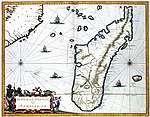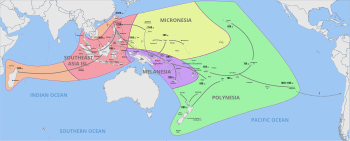
Back تاريخ مدغشقر Arabic Historia de Madagascar AST Istor Madagaskar Breton Història de Madagascar Catalan Dějiny Madagaskaru Czech Geschichte Madagaskars German Ιστορία της Μαδαγασκάρης Greek Historia de Madagascar Spanish Madagaskari ajalugu Estonian Madagaskarko historia Basque
This article's lead section may be too long. (January 2024) |
| Part of a series on the |
| Culture of Madagascar |
|---|
 |
| Society |
| Topics |
| Symbols |
| History of Madagascar |
|---|
 |
|
The History of Madagascar started from the ancient supercontinent of Pangaea, containing amongst others the African continent and the Indian subcontinent, and by the island's late colonization by human settlers from the Sunda islands (Malay Archipelago) and from East Africa.[1] These two factors facilitated the evolution and survival of thousands of endemic plant and animal species, some of which have gone extinct or are currently threatened with extinction. Trade in the Indian Ocean at the time of first colonization of Madagascar was dominated by Indonesian ships, probably of Borobudur ship and K'un-lun po types.[2][3]
Over the past two thousand years the island has received waves of settlers of diverse origins including Austronesian, Bantu, Arab, South Asian, Chinese, and European. The majority of the population of Madagascar today is a mixture of Austronesian and Bantu settlers. Despite popular belief, there has been no genetic input from Arabs or Indians, although one tribe, the Antemoro, claims descent from Somali Arab traders. European and Middle eastern paternal ancestry is also present.[4]
Centuries of intermarriages created the Malagasy people, who primarily speak Malagasy, an Austronesian language with Bantu, Malay, Oceanic, Arabic, French, and English influences. Most of the genetic makeup of the average Malagasy, however, reflects an almost equal blend of Austronesian and Bantu.[5][6] One study concludes that Madagascar was first settled approximately 1,200 years ago by a very small group containing approximately 30 women, with 28 of them of maritime Southeast Asian descent and 2 of African descent.[7] But this result is not consistent with more extensive data accumulated.[8] The Malagasy population formed through the intermixing of the first founding population with later immigrants.
Other ethnic groups often intermixed with the existent population to a more limited degree or have sought to preserve a separate community from the majority Malagasy.


By the Middle Ages, over a dozen distinct ethnic identities had emerged on the island, typified by rule under a local chieftain. Some communities, such as the Sakalava, Merina and Betsimisaraka, were unified by leaders who established true kingdoms, which gained wealth and power through commerce with Europeans, Arabs, and other seafarers, including pirates.
Between the 16th and 18th centuries, pirate activity in the coastal areas of Madagascar was common. The purported free pirate colony of Libertatia was established on Île Sainte-Marie, originally populated by local Malagasy. The Sakalava and Merina kingdoms in particular exploited European trade to strengthen the power of their kingdoms, trading Malagasy slaves for European firearms and other goods. Throughout this time, European and Arab seafarers operating in the Indian Ocean traded with coastal communities, and Europeans made several unsuccessful attempts to claim and colonize the island. Beginning in the early 19th century, the British and French competed for influence in Madagascar.
By the turn of the 19th century, King Andrianampoinimerina had reunited the highly populous Kingdom of Imerina in the central highlands, with its capital at Antananarivo. His son Radama I the Great expanded its authority to the island's other polities and was the first Malagasy sovereign to be recognized by foreign states as the ruler of the greater Merina Kingdom. Following the ferocious attempts by Queen Ranavalona I (r. 1828–1861) to eradicate the Christian influence, over the 19th century, some of Merina monarchs engaged in the process of modernization through close diplomatic ties to Britain that led to the establishment of European-style schools, government institutions and infrastructure. Christianity, introduced by the London Missionary Society, was made the state religion under Queen Ranavalona II and her powerful prime minister Rainilaiarivony. Political wrangling between Britain and France in the 1880s resulted in Britain recognizing France's authority on the island. This led in 1890 to the Malagasy Protectorate, which was however rejected by the native government of Madagascar. The French launched the two Franco-Hova Wars to force submission, finally capturing the capital in September 1895. The conflict continued in the widespread Menalamba rebellion against French rule that was crushed in 1897. The native monarchy was dissolved, and the queen and her entourage exiled to Reunion and later Algeria, where she died in 1917. Following conquest, the French abolished slavery in 1896, freeing approximately 500,000 slaves.[9]
In French Madagascar, Malagasy people were required to fulfill corvée labor on French-run plantations, which generated high revenues for the colonial administration. Opportunities for Malagasy to access education or skilled positions within the colonial structure were limited, although some basic services like schools and clinics were extended to coastal areas for the first time. The capital city was largely transformed and modernized, and the royal palace was transformed into a school and later a museum. Although Malagasy were initially prevented from forming political parties, several militant nationalist secret societies emerged, of which the most prominent was Vy Vato Sakelika, founded by Ny Avana Ramanantoanina.
Many Malagasy were conscripted to fight for France in World Wars I and II, and during the latter Madagascar came under Vichy control before being captured and occupied by the British in the Battle of Madagascar. At the Brazzaville Conference of 1944, Charles de Gaulle gave the colony the status of an overseas territory with the right to representatives in the French National Assembly. When a bill proposed by Malagasy delegates of the Mouvement démocratique de la rénovation malgache for Madagascar's independence was not passed, militant nationalists led an unsuccessful Malagasy uprising (1947–1948), during which the French military committed atrocities that deeply scarred the population. The country gained full independence from France in 1960 in the wake of decolonization.
Under the leadership of President Philibert Tsiranana, Madagascar's First Republic (1960–1972) was established as a democratic system modeled on that of France. This period was characterized by continued economic and cultural dependence upon France, provoking resentment and sparking the rotaka, popular movements among farmers and students that ultimately ushered in the socialist Democratic Republic of Madagascar under Admiral Didier Ratsiraka (1975–1992) distinguished by economic isolationism and political alliances with pro-Soviet states. As Madagascar's economy quickly unraveled, standards of living declined dramatically and growing social unrest was increasingly met with violent repression on the part of the Ratsiraka government. By 1992, free and fair multiparty elections were held, ushering in the democratic Third Republic (1992–2009). Under the new constitution, the Malagasy public elected successive presidents Albert Zafy, Didier Ratsiraka, and Marc Ravalomanana. This latter was ousted in the 2009 Malagasy political crisis by a popular movement under the leadership of Andry Rajoelina, then-mayor of Antananarivo, in what was widely characterized as a coup d'état. Rajoelina ushered in the Malagasy constitutional referendum, 2010 and ruled Madagascar as president of the High Transitional Authority without recognition from the international community. Elections were held on December 20, 2013, to elect a new president and return the country to constitutional governance.
- ^ Heiske, Margit; Alva, Omar; Pereda-Loth, Veronica; Van Schalkwyk, Matthew; Radimilahy, Chantal; Letellier, Thierry; Rakotarisoa, Jean-Aimé; Pierron, Denis (2021). "Genetic evidence and historical theories of the Asian and African origins of the present Malagasy population". Human Molecular Genetics. 30 (R1): R72–R78. doi:10.1093/hmg/ddab018. PMID 33481023.
- ^ Beale, Philip (2006). "From Indonesia to Africa: Borobudur Ship Expedition". ZIFF Journal. 3: 17–24.
- ^ Manguin, Pierre-Yves (September 1980). "The Southeast Asian Ship: An Historical Approach". Journal of Southeast Asian Studies. 11 (2): 266–276. doi:10.1017/S002246340000446X. JSTOR 20070359. S2CID 162220129.
- ^ Pierron, Denis; Heiske, Margit; Razafindrazaka, Harilanto; Rakoto, Ignace; Rabetokotany, Nelly; Ravololomanga, Bodo; Rakotozafy, Lucien M.-A.; Rakotomalala, Mireille Mialy; Razafiarivony, Michel; Rasoarifetra, Bako; Raharijesy, Miakabola Andriamampianina (August 8, 2017). "Genomic landscape of human diversity across Madagascar". Proceedings of the National Academy of Sciences. 114 (32): E6498–E6506. Bibcode:2017PNAS..114E6498P. doi:10.1073/pnas.1704906114. ISSN 0027-8424. PMC 5559028. PMID 28716916.
- ^ Pierron, Denis; Razafindrazaka, Harilanto; Pagani, Luca; Ricaut, François-Xavier; Antao, Tiago; Capredon, Mélanie; Sambo, Clément; Radimilahy, Chantal; Rakotoarisoa, Jean-Aimé; Blench, Roger M.; Letellier, Thierry (January 21, 2014). "Genome-wide evidence of Austronesian–Bantu admixture and cultural reversion in a hunter-gatherer group of Madagascar". Proceedings of the National Academy of Sciences. 111 (3): 936–941. Bibcode:2014PNAS..111..936P. doi:10.1073/pnas.1321860111. ISSN 0027-8424. PMC 3903192. PMID 24395773.
- ^ Sanger Institute (May 4, 2005). "The cryptic past of Madagascar: Human inhabitants of Madagascar are genetically unique". Archived from the original on March 3, 2011. Retrieved April 30, 2006.
- ^ Cox, Murray P.; Nelson, Michael G.; Tumonggor, Meryanne K.; Ricaut, François-X.; Sudoyo, Herawati (2012). "A small cohort of Island Southeast Asian women founded Madagascar". Proceedings of the Royal Society B: Biological Sciences. 279 (1739): 2761–2768. doi:10.1098/rspb.2012.0012. PMC 3367776. PMID 22438500.
- ^ Cite error: The named reference
:0was invoked but never defined (see the help page). - ^ Shillington (2005), p. 878